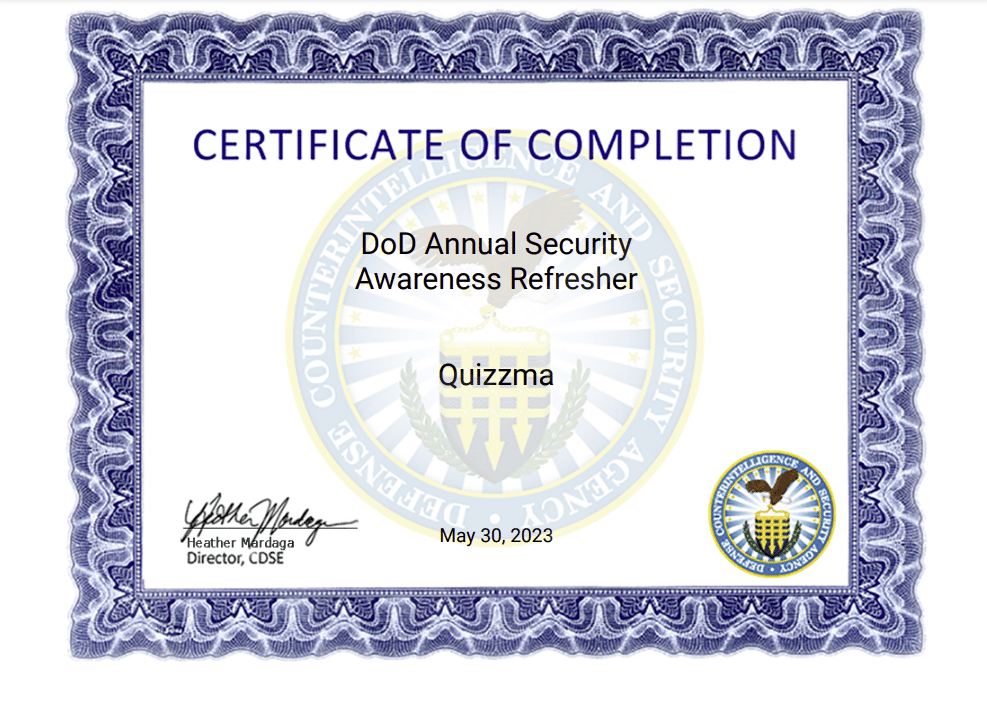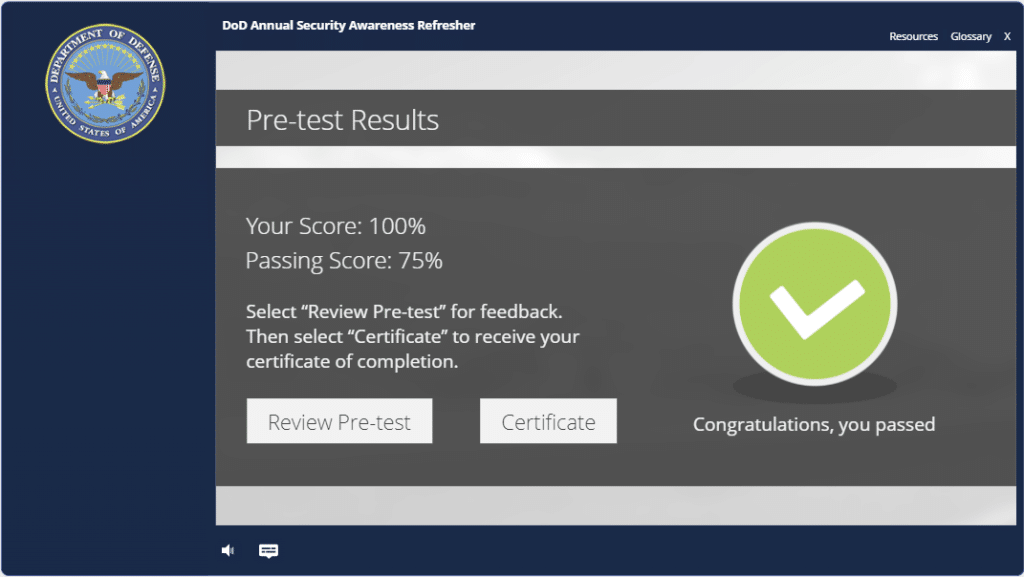Welcome to the DoD Annual Security Awareness Refresher answers. This training provides a review of basic security principles and the responsibilities to protect DoD assets.
The defense domain is intricate and ever-evolving, making it crucial for personnel to stay updated with the latest protocols and security measures. This guide is meticulously curated to assist learners in revisiting and reinforcing their foundational knowledge of security protocols and practices.
The content is aligned with the guidelines set in DODM 5200.01 Volume 3, Enclosure 5, the National Industrial Security Program Operating Manual (NISPOM), and other pertinent policies.
The Department of Defense (DOD) emphasizes continuous learning and timely refreshers in an era marked by multifaceted security challenges. This study guide offers a comprehensive overview of the core areas and components covered in the DOD Annual Security Awareness Refresher course.
DOD Annual Security Awareness Refresher Pre-Test Answers
In order to obtain a certificate of completion, you need to achieve a score of 75% or higher.

- Physical security is concerned with and __ measures designed to prevent unauthorized access.
– Active, Passive
– Active, Inactive
– Access control, active - Which of the following are parts of the OPSEC process?
– Analysis of threats
– Application of appropriate countermeasures
– Conduct vulnerability assessments
– Identification of sensitive information - Derivative classifiers are required to have all the following except?
– Approval of the original classification authority (OCA)
– A security clearance
– a need-to-know - Which of the following must be reported?
– Change in status
– Adverse Information
– Foreign contacts
– All of the above - When opening and closing a security container, complete the __?
– SF 700
– SF 701
– SF 702
– SF 703 - Incorporating, paraphrasing, restating, or generating in new form information that is already classified is known as __?
– Derivative classification
– Original classification
– Declassification - Which of the following is required to access classified information?
– Signed SF 312
– Clearance eligibility at the appropriate level
– Need-to-know
– Approval of your supervisor - Secret materials may be transmitted y the same methods as Confidential materials.
– True
– False - The physical security program prevents unauthorized access to which of the following?
– Personnel
– Facilities
– Information
– Equipment - What is the standard form of identification for DoD employees?
– Common access card (CAC)
– Real ID
– State issue driver’s license - Top Secret documents can be transmitted by which of the following methods?
– Defense Courier Service
– Secure Fax
– FedEx
– U.S. Postal Service - Which method may be used to transmit Confidential materials to DoD agencies?
– USPS First class mail
– Street side collection box
– USPS Fourth class mail - The Personnel Security Program establishes __ for Personnel Security determinations and overall program management responsibilities.
– Policies and Procedures
– Job selection criteria
– Clearance classification - How often must you receive a defensive foreign travel briefing?
– At least once a year
– Prior to Travel
– Every two years - What coversheet is attached to help protect a Secret document?
– SF 704
– SF 705
– SF 706 - Prior to foreign travel, you must ensure that your Antiterrorism/Force Protection Level 1 training is current.
– True
– False - Which of the following materials are subject to pre-publication review?
– Speeches
– Articles
– Books - What form is used to record end-of-day security checks?
– SF 700
– SF 701
– SF 702
– SF 703 - A security infraction involves loss, compromise, or suspected compromise.
– True
– False - You may be subject to sanctions if you negligently disclose classified information.
– True
– False - Classified information can be destroyed using which of the following methods?
– Burning
– Shredding
– Pulverizing - Classified information can be safeguarded by using __?
– Vaults
– Secure Rooms
– Secure telephones - What form is used to request a background investigation?
– SF 86
– SF 312
– SF 700 - Which level of classified information could cause damage to national security if compromised?
– Confidential
– Secret
– Top Secret

Test Preparation
Pre-Test Overview
- Purpose:
- The pre-test serves a dual function. First, it gauges your foundational knowledge about DOD security procedures before embarking on the course. This can help you identify areas of strength and weakness. Secondly, a strong performance on the pre-test might reduce the need for extensive revision on particular topics, allowing you to focus on other areas.
- Key Areas:
- The test majorly revolves around:
- Basic security guidelines as laid out in DODM 5200.01 Volume 3, Enclosure 5.
- The principles and protocols stipulated in the NISPOM.
- Additional relevant security policies and regulations.
- The test majorly revolves around:
Post-Test Overview
- Purpose:
- The post-test is designed to measure the efficacy of the course. By comparing pre-test and post-test scores, you can measure tangible improvement. Moreover, it serves as a verification tool, ensuring that learners have absorbed crucial information and are ready to implement their knowledge practically.
- Focus Areas:
- The post-test often zeroes in on:
- Real-world application of security guidelines.
- Critical scenarios that might arise in a defense security environment.
- Analysis and understanding of complex security policies.
- The post-test often zeroes in on:
Sample Questions and Answers
- Mock Tests:
- Q1. Which volume and enclosure of DODM 5200.01 specifically deals with security training requirements?
- Q2. What is the primary objective of the NISPOM?
- Answer Key:
- A1. DODM 5200.01 Volume 3, Enclosure 5.
- A2. The NISPOM’s main objective is to prescribe the baseline standards for the protection of classified information released or disclosed to industry.
Study Tips
- Active Revision:
- Summarization: After each module, write concise notes summarizing the main points.
- Visualization: Use diagrams, flowcharts, or mind maps to visualize complex processes.
- Mnemonic Creation: Construct mnemonics for tricky terms or lists.
- Time Management:
- Study Sessions: Break your study time into manageable chunks. For instance, study for 50 minutes and take a 10-minute break.
- Scheduling: Dedicate specific times in the day for revising particular topics. Stick to this timetable.
- Group Study:
- Discussion: Engage in spirited discussions to get various viewpoints on a topic.
- Quiz Sessions: Team up and quiz each other on different modules.
Resources for Further Reading
- Recommended Texts:
- “Security Management for the Defense Department” by John A. Smith.
- “National Security Protocols: A Comprehensive Guide” published by DOD Publications.
- Online Platforms:
- DOD’s official website offers a wealth of information and latest updates.
- Security Forums on platforms like SecNet and DefGuard provide insights from professionals in the field and can be great platforms to ask questions and seek advice.
Course Resources for DOD Annual Security Awareness Refresher Training IF142.06



